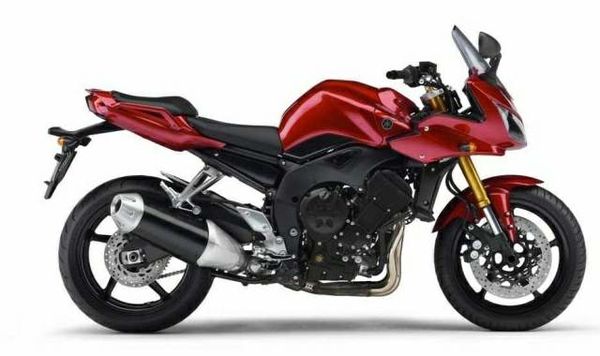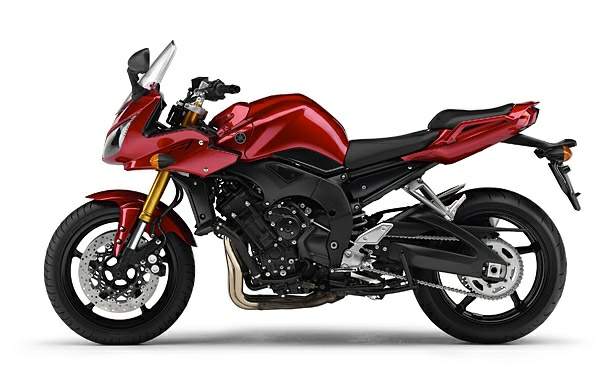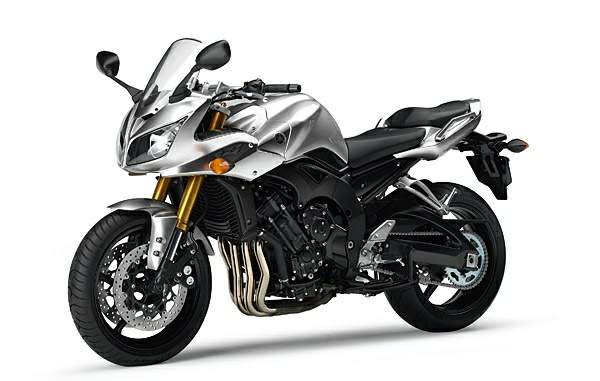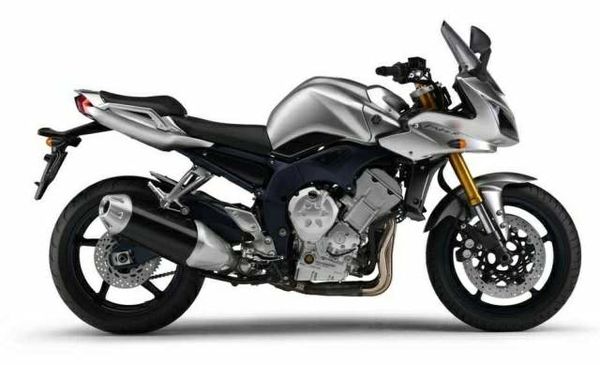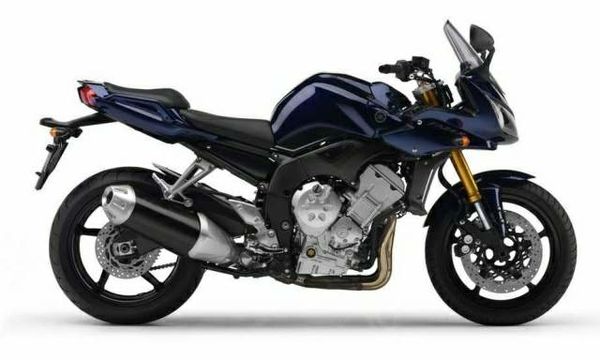Yamaha FZ-1 Fazer
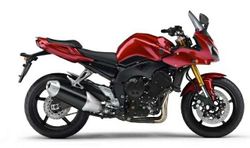 |
|
| Yamaha FZ-1 Fazer | |
| Manufacturer | |
|---|---|
| Production | 2006 |
| Engine | Four stroke, transverse four cylinder, DOHC, 5 valve per cylinder |
| Compression ratio | 11.5:1 |
| Top Speed | 246.1 km/h |
| Ignition | Digital TCI: Transistor Controlled Ignition with 32-bit ECU |
| Spark Plug | NGK, CR9EK |
| Transmission | 6 Speed |
| Frame | Aluminum die-cast, diamond shaped |
| Suspension | Front: Telescopic upside forks, Rear: Link-type swingarm, |
| Brakes | Front: 2x 320mm discs 4 piston calipers Rear: Single 245mm disc 1 piston caliper |
| Front Tire | 120/70 ZR17 |
| Rear Tire | 190/50 ZR17 |
| Wheelbase | 1461 mm / 57.5 in |
| Seat Height | 815 mm / 32.1 in |
| Weight | 198 kg / 436.5 lbs (dry), 221 kg / 487 lbs (wet) |
| Recommended Oil | Yamalube 10w-40 |
| Fuel Capacity | 18 Liters / 4.76 gal |
| Manuals | Service Manual |
It could reach a top speed of 246.1 km/h.
Engine[edit | edit source]
The engine was a Liquid cooled cooled Four stroke, transverse four cylinder, DOHC, 5 valve per cylinder. The engine featured a 11.5:1 compression ratio.
Drive[edit | edit source]
Power was moderated via the Wet, multiple discs, hydraulic operated.
Chassis[edit | edit source]
It came with a 120/70 ZR17 front tire and a 190/50 ZR17 rear tire. Stopping was achieved via 2x 320mm discs 4 piston calipers in the front and a Single 245mm disc 1 piston caliper in the rear. The front suspension was a Telescopic upside forks, while the rear was equipped with a Link-type swingarm,. The FZ-1 Fazer was fitted with a 18 Liters / 4.76 gal fuel tank. The bike weighed just 198 kg / 436.5 lbs. The wheelbase was 1461 mm / 57.5 in long.
Photos[edit | edit source]
Overview[edit | edit source]
Yamaha FZ-1 Fazer
Stripped to the essentials, the FZ1 eats up the urban sprawl with its awesome R1-based motor and super-agile chassis. This is a no-nonsense motorcycle that owns the streets, day and night. Features Key Features: Our ultimate street brawler brings 998cc of fuel-injected R1 power to the fray, in a light and strong aluminum frame. Sculpted fuel tank and a real-live handlebar move the rider forward for aggressive naked-bike excitement. Adjustable suspension at both ends lets the FZ1 be dialed in for a wide range of useseverything from track days to urban assault to sport touring.
Engine:
998cc DOHC 20-valve R1 engine is tuned for tremendous mid-range punch and
massive top-end power.
R1-style fuel injection with computer-controlled sub-throttle valves
provides precise fuel/air mixture for superb power delivery across the
entire rev range.
Closed-deck cylinder block provides great strength while allowing a narrow
engine in spite of big, 77mm bores.
Narrow-angle five-valve combustion chambers produce a highly efficient
11.5:1 compression ratio. Big valves and high-lift cams flow plenty of air.
Carburized connecting rods with fractured big ends produce a quick-revving
engine with excellent high-rpm durability.
High silicon-content ceramic-composite cylinder sleeves ensure great heat
dissipation for consistent power delivery and reduced friction.
Four-into-one chamberless short-style exhaust contains stainless steel EXUP
and three-way catalyst with O2 sensor for outstanding power delivery
throughout the rev range and low emissions.
Curved high-capacity radiator with twin ring-style fans keeps everything
cool under all conditions.
Chassis/Suspension:
Aggressive chassis geometry for quick handling: the engines shoved forward for excellent handling. Aggressive ergos: 4.75-gallon tank moves the rider forward into a position of total controlsupersport-like 51 percent front wheel weight bias means confident, quick handling. Light and rigid aluminum frame uses a special mold casting technique that allowed engineers to minutely vary metal thicknesses for optimal rigidity throughout. Stressed-engine design holds the engine in place with six mounts, for excellent vertical stiffness and handling. Two-inch longer and more rigid Controlled Fill aluminum swingarm reduces drive chain-induced suspension movement for excellent handling, tire grip and looks. 43mm fully adjustable inverted fork contains compression damping circuitry in the left leg and rebound in the rightproven effective on the YZR-M1 MotoGP bikeas well as stiffer springs for excellent handling. Two 320mm front discs squeezed by monoblock four-piston calipers and a single 245mm rear disc serve up strong stopping power. Removable subframe for easy maintenance, and detachable passenger footpeg mounts for even more stripped-down style. Light, R1-spec five-spoke wheels and fat radial tires, including a 190/50-ZR17 rear, complete the look and serve up the traction.
Additional Features: Fairing features a half-cowl design with R1-style headlight layout that creates a super-aggressive naked bike profile. High-tech instrument display features analog tachometer, digital speedometer, etc.also a fade-in lighting feature with adjustable brightness. Two-piece seat serves up great comfort along with total control. Passenger grabrails for riding comfort. Durable O-ring-sealed drive chain provides longer chain life. Dual 12V 60/55-watt multireflector headlight features a sleek, R1-type profile for superb aerodynamics and visibility.
A lot of water has passed under the proverbial bridge in the half decade since Yamahas first-generation FZ1 was introduced, and the world is a different place. When that groundbreaking 2001 model was launched, company officials later admitted, they were skeptical that customers would flock to it in sufficient quantity. Thankfully, history has shown once again (as it also did with the FJR1300) that if you build a quality, fun-to-ride bike at a fair price, buyers will come.
Advertisement Rider Report
After living with it for a while, however, some current owners along with respondents in consumer clinics asked for upgrades such as an aluminum frame, higher horsepower, better brakes and more sophisticated suspension. Yamaha has answered the call with a slew of changes, taking the FZ1 a full step deeper into the sporty realm while still leaving enough of the old bikes charm that owners have come to love.
To remedy one of the most common gripesthat the FZ1s engine was detuned too much compared to the YZF-R1 powerplant upon which its basedYammies engineers started with the newer and more-powerful R1 engine used for the last three years. The FZ1 now shares the same case and cylinder head castings as the 2005 R1, although compression has been lowered slightly to 11.5:1. Intake camshafts now have more lift than before to help it breathe, and they tossed out the smallish carburetors and brought in fuel injection.
Rider Report
With the new injection the engine lights off instantly cold or hot, and theres no idle-control lever to fiddle with anymore. On the first start in the morning, other than a faster idle, its difficult to tell the engine is cold. Within a few blocks the idle speed comes down and as the coolant temperature comes up to normal, its good to go. A second thermostatically controlled fan has been added to cope with the extra horsepower.
The FZ1s engine is very flexible; you can idle along in first gear in traffic without bucking, and lug it down to 30 mph in sixth if the authorities are around. Yet the bike loves to rev and makes its best power just shy of the rev limiter. There is a tradeoff, however, and it is low-end torque. Launching the bike from a standstill requires a little more clutch work than before, and it helps to carry more revs, slipping the clutch longer to get going initially. Power starts to build more quickly above 4,000 rpm; by five grand it takes off screaming in pursuit of its 12,000-rpm redline. Passing performance is wonderful, just zing it down
a cog or two and those slowpokes dawdling along become a dot in your mirrors instantly. At all sane speeds (and some that arent), the engine remains smooth with little four-cylinder buzziness. Thick rubber footpeg pads and rubber isolators at the footpegs and handlebar risers ensure that very little vibration gets through to the rider.
Rider Report
We ran our 2006 model on a Dynojet dynamometer and compared the results to our previous runs with the last-generation FZ1. Rear-wheel horsepower is up by six ponies to 131. This can really be felt in the top-end rushthe bike was powerful before, and now its truly a screamer. Peak horsepower now arrives at 11,500 rpm instead of the prior 9,750, but with a ferocity more akin to the R1. The torque graph line is quite smooth and flat; torque, however, has slid by 4 lb-ft, from a peak of 72.2 lb-ft at 7,500 rpm in last years bike down to 68.0 at 9,250 revs.
For oh-six the same wet clutch is shared with the R1. Clutch-lever pull with the cable-actuated system is on the high end of moderate, yet modulation is excellent and it hooks up well with no unwanted slippage or chattering. A hydraulically actuated clutch would be nice for those traffic jams and winding mountain roads, though.
Gear ratios are well matched to the character of the engine. The close ratios allow the rider to short shift around town, and fifth and sixth gear are now slightly taller for more relaxed highway cruising. Neutral is easy to find, even when stopped, and gear changes are free of false neutrals. We noticed that when upshifting at low rpm the gearbox feels a little notchy and stiff, but then again it wasnt fully broken in yet.
Rider Report Both tach and speedo are easy to read. Tall rubber-mounted risers isolate vibration and add comfort. As is the trend lately, the new FZ1 has a lower, shorter muffler that ends amidships. This brings several benefits, including more centralized mass, moving the weight down and providing better clearance for saddlebags on the right side. An EXUP valve varies backpressure, and engine sound is healthy but not excessively loud, with good tonal quality. An oxygen sensor provides closed-loop feedback emission control and two catalysts (one in the pipe) scrub the exhaust clean.
Switching from a tubular-steel frame to an aluminum one not only lightens and improves the look of the bike, it also makes the chassis less flexible and adds a solid feel. According to Yamaha, the frame itself is 52 percent lighter, but with the rear subframe, the combined assembly is 37 percent lighter than the previous steel unit. A centerstand is still included, which youll appreciate when it comes time to clean the bike, check tire pressure or adjust the chain.
Yamaha changed from a conventional SOQI-brand fork to a fully adjustable
male-slider Kayaba unit with separate controls for preload, compression and
rebound damping. Interestingly, the left leg handles compres-sion damping while
the right controls rebound; read the owners manual before fiddling with
settings.
Rider Report
New calipers make the FZ1 stop even better, with good feedback.
In back, youll find a single shock with seven-step adjustable preload. The
required tool is in the toolkit and access is reasonable. Rebound is also
adjustable, but not compression damping. The swingarm has been upgraded, and
this year the FZ1 gets the same cool-looking, five-spoke wheels as the R1. Ride
quality is firmer and more controlled than before, and some of the plushness
seems to have gone away. Some of this can be regained by adjusting the
suspension if desired.
Brakes have been upgraded this year, with radial-mounted four-piston front calipers now grabbing the dual rotors. In back, one disc with a single-piston caliper does the job. Stopping is better than ever, with excellent feel and tremendous, fade-free stopping power and low lever effort in front. The rear brake adds a further measure of braking without being overly sensitive.
The FZ1 feels sure-footed and instills confidence in its ridermore so than its predecessor. It rails nicely through all sorts of turns, changes direction easily, and even has a tight turning radius. Standard fitment tires are Michelin Pilot Road or Dunlop D221; our test bike had the Michelins. These tires typically last longer than some of the more sticky sportbike rubber, yet they dont seem to warm up quickly. However, they worked well on dry roads or wet, dont chase pavement grooves, are stable at high speed and deliver good all-around grip and performance.
Rider Report
FZ1's powerplant is more similar to the R1's than before, with six more
horsepower.
Coming at you, the FZ1 appears similar to most current sportbikes, except that
the windscreen is narrow and slopes up more vertically. While wind protection is
similar to a sportbike, with good coverage of the lower body, the abbreviated
screen seems to create some helmet buffetingmuch as it did before.
They may look awkWard, but the long mirror stalks are steady and the mirrors provide a wide panorama behind the bike. Both headlights operate all the time on both low and high beams. This results in well-above-average lighting on the dipped beam, and the high beams are awesome, slashing a wide swath far into the night.
The instrument cluster has some interesting features. A large analog tachometer is combined with a digital speedometer in one multifunction unit. Besides the obligatory indicator lamps, you get twin tripmeters, a bar-graph fuel gauge, a fuel-reserve tripmeter (which shows distance traveled since the fuel-meter started flashing), a clock and a digital coolant temperature readout you can toggle over to an intake (ambient) air temperature indicator. Theres also a brightness control mode.
Along with more horsepower and sportier suspension and chassis specs, the FZ1s rider accommodations have been changed accordingly. The revised flat-track-style handlebar is an inch lower and a half-inch back. Front footpegs are now moved about an inch farther back and 2?3-inch higher. Gone is the large one-piece saddle, replaced by individual seats for rider and pillion. We miss the old seat and the storage space underneath. Passenger accommodations are also not as plush as before, with a small pillion pad and rather high-mounted footpegs.
Fuel mileage varied between 31.8 and 38.8, with an average of 35.3 mpg. The fuel tank has been reduced in capacity to 4.76 gallons, although it seems wider than before. Crunch the numbers and you get a calculated range of about 168 miles. Expect the low-fuel indicator to start blinking at you between 115 to 130 miles, depending on riding conditions.
Luggage for a multiday jaunt is easy to mount. The main part of the gas tank is still made of steel so magnetic tankbags will stick. Seatbags sit well on the flat pillion seat and thanks to the shorty muffler theres more room for panniers than before.
Our FZ1 had an excellent finish, quality plating and powdercoating. It seemed well sorted and everything worked as it should with no problems. We particularly liked the styling of the new swingarm and midship exhaust. Notably the bike only requires valve adjustments every 26,600 milesother maintenance chores are minor.
Rider Report
Like sportbikes, but tired of their extreme riding positions? Tried cruisers, but found they dont have enough zip? In the new FZ1, Yamaha has developed an exciting, fun-to-ride machine with stunning performance, without the torture-rack ergonomics, and at a price close to that of the 600cc sportbikes that should appeal to a wide audience of buyers.
Source
| Make Model | Yamaha FZ-1 Fazer |
|---|---|
| Year | 2006 |
| Engine Type | Four stroke, transverse four cylinder, DOHC, 5 valve per cylinder |
| Displacement | 998 cc / 60.9 ci-in |
| Bore X Stroke | 77 X 53.6 mm |
| Cooling System | Liquid cooled |
| Compression | 11.5:1 |
| Lubrication | Wet sump |
| Engine Oil | Synthetic, 20W/40 |
| Induction | Fuel injection |
| Ignition | Digital TCI: Transistor Controlled Ignition with 32-bit ECU |
| Spark Plug | NGK, CR9EK |
| Starting | Electric |
| Max Power | 146.8 hp / 108 kW @ 11000 rpm |
| Max Torque | 106 Nm /10.5 kgf-m / 76.7 ft-lb @ 8000 rpm |
| Clutch | Wet, multiple discs, hydraulic operated |
| Transmission | 6 Speed |
| Final Drive | O-ring chain |
| Frame | Aluminum die-cast, diamond shaped |
| Front Suspension | Telescopic upside forks, |
| Front Wheel Travel | 130 mm / 5.1 in |
| Rear Suspension | Link-type swingarm, |
| Rear Wheel Travel | 130 mm / 5.1 in |
| Front Brakes | 2x 320mm discs 4 piston calipers |
| Rear Brakes | Single 245mm disc 1 piston caliper |
| Front Tire | 120/70 ZR17 |
| Rear Tire | 190/50 ZR17 |
| Rake | 25.0° |
| Trail | 109 mm / 4.3 in |
| Dimensions | Height 1204 mm / 47.4 in Length 2141 mm / 84.3 in Width 770 mm / 30.3 in |
| Wheelbase | 1461 mm / 57.5 in |
| Ground Clearance | 135 mm / 5.3 in |
| Seat Height | 815 mm / 32.1 in |
| Dry Weight | 198 kg / 436.5 lbs |
| Wet Weight | 221 kg / 487 lbs |
| Fuel Capacity | 18 Liters / 4.76 gal |
| Standing ¼ Mile | 11.1 sec |
| Consumption Average | 13.4 km/lit |
| Top Speed | 246.1 km/h |
